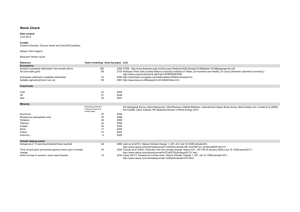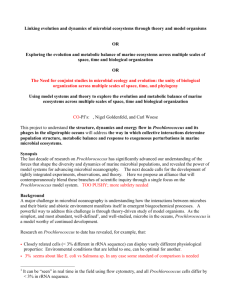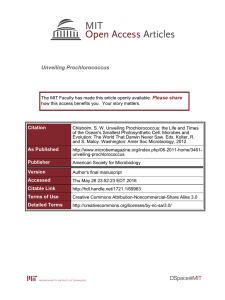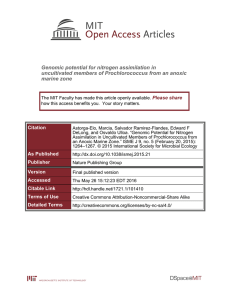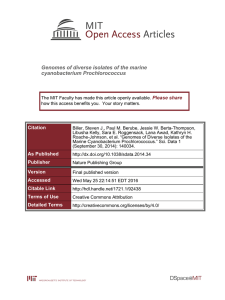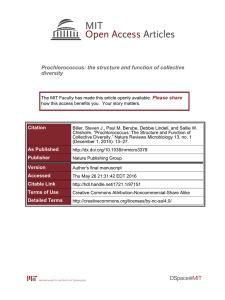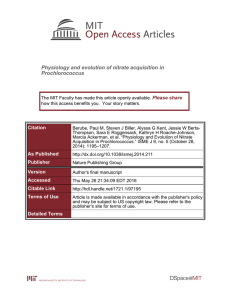Draft Genome Sequence of Alteromonas Macleodii Strain
advertisement
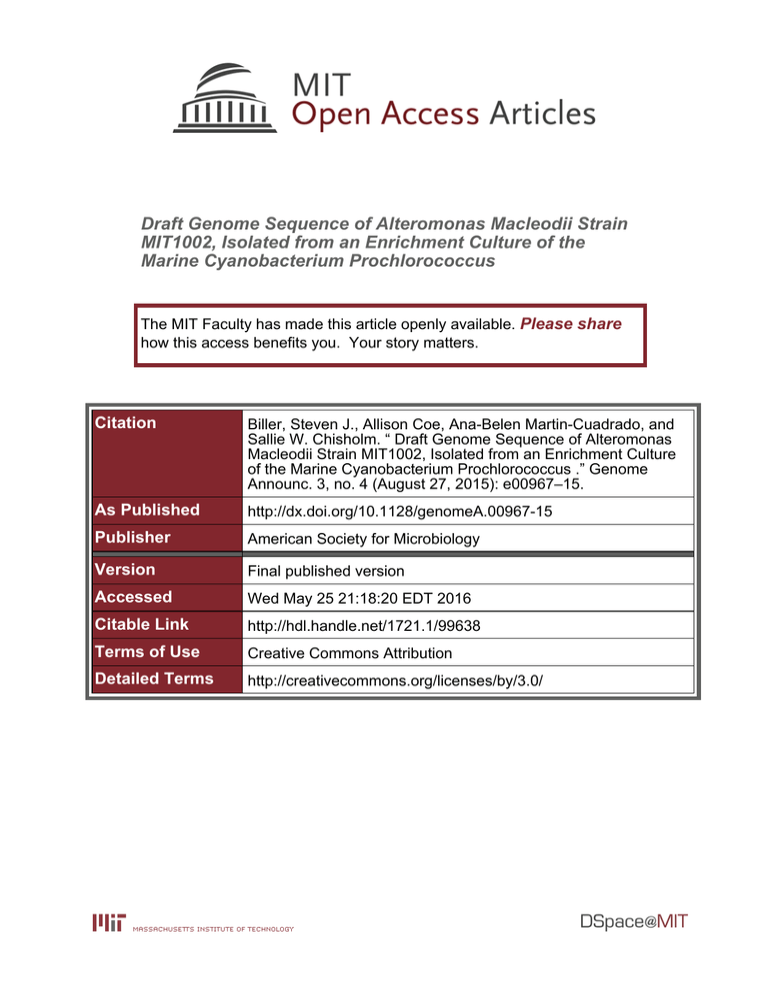
Draft Genome Sequence of Alteromonas Macleodii Strain MIT1002, Isolated from an Enrichment Culture of the Marine Cyanobacterium Prochlorococcus The MIT Faculty has made this article openly available. Please share how this access benefits you. Your story matters. Citation Biller, Steven J., Allison Coe, Ana-Belen Martin-Cuadrado, and Sallie W. Chisholm. “ Draft Genome Sequence of Alteromonas Macleodii Strain MIT1002, Isolated from an Enrichment Culture of the Marine Cyanobacterium Prochlorococcus .” Genome Announc. 3, no. 4 (August 27, 2015): e00967–15. As Published http://dx.doi.org/10.1128/genomeA.00967-15 Publisher American Society for Microbiology Version Final published version Accessed Wed May 25 21:18:20 EDT 2016 Citable Link http://hdl.handle.net/1721.1/99638 Terms of Use Creative Commons Attribution Detailed Terms http://creativecommons.org/licenses/by/3.0/ crossmark Draft Genome Sequence of Alteromonas macleodii Strain MIT1002, Isolated from an Enrichment Culture of the Marine Cyanobacterium Prochlorococcus Steven J. Biller,a Allison Coe,a Ana-Belen Martin-Cuadrado,b Sallie W. Chisholma,c Department of Civil and Environmental Engineering, Massachusetts Institute of Technology, Cambridge, Massachusetts, USAa; Departamento de Producción Vegetal y Microbiología, Universidad Miguel Hernandez, Alicante, Spainb; Department of Biology, Massachusetts Institute of Technology, Cambridge, Massachusetts, USAc Alteromonas spp. are heterotrophic gammaproteobacteria commonly found in marine environments. We present here the draft genome sequence of Alteromonas macleodii MIT1002, which was isolated from an enrichment culture of the marine cyanobacterium Prochlorococcus NATL2A. This genome contains a mixture of features previously seen only within either the “surface” or “deep” Alteromonas ecotype. Received 16 July 2015 Accepted 21 July 2015 Published 27 August 2015 Citation Biller SJ, Coe A, Martin-Cuadrado A-B, Chisholm SW. 2015. Draft genome sequence of Alteromonas macleodii strain MIT1002, isolated from an enrichment culture of the marine cyanobacterium Prochlorococcus. Genome Announc 3(4):e00967-15. doi:10.1128/genomeA.00967-15. Copyright © 2015 Biller et al. This is an open-access article distributed under the terms of the Creative Commons Attribution 3.0 Unported license. Address correspondence to Steven J. Biller, sbiller@mit.edu, or Sallie W. Chisholm, chisholm@mit.edu. A lteromonas spp. are copiotrophic bacteria widely distributed throughout the marine environment, where they can play a notable role in the processing of dissolved organic carbon pools (1, 2). The type strain of this group is Alteromonas macleodii ATCC 27126, which was isolated from surface waters in Hawaii (3); since then, Alteromonas spp. have been obtained from diverse locations, including deep (⬎1,000 m) waters in the Mediterranean. Genomic analyses have shown that A. macleodii strains cluster into two phylogenetic groups, termed the “surface” and “deep” ecotypes, correlated with where they were found in the water column (4). Recently, the deep group was reclassified as a separate species, Alteromonas mediterranea (5). We isolated A. macleodii MIT1002 in 2010 from an enrichment culture of the marine cyanobacterium Prochlorococcus NATL2A, originally isolated in 1990 from seawater collected at a 10-m depth in the North Atlantic (38°59=N 49°44=W) (6). The enrichment culture had been maintained for more than two decades via serial transfer in sterile natural seawater-based Pro99 medium (7) at 21°C under ~40 mol photon m-2 s-1 illumination. As Pro99 does not contain any added organic carbon to support the growth of A. macleodii MIT1002, Prochlorococcus must have provided this strain with organic carbon and perhaps other nutrients. A. macleodii MIT1002 was isolated by streaking a sample of the Prochlorococcus NATL2A culture onto a ProMM plate (Pro99 plus lactate, pyruvate, glycerol, acetate, Va vitamins, and 1.4% Noble agar) (8), and allowing cells to grow at room temperature. Following colony purification, the isolate was maintained in liquid ProMM medium. Genomic DNA libraries were prepared as previously described (9) and sequenced on an Illumina GAIIx, yielding approximately 480,000 200 ⫻ 200-nucleotide (nt) paired-end reads. These were overlapped using SHERA (10), with default settings. Low-quality regions of the reads were removed using qualitytrim (version 3.2; CLC bio) and assembled by the Newbler assembler (version 2.6; July/August 2015 Volume 3 Issue 4 e00967-15 454/Roche), with the following parameters: “-e 200 –rip.” We retained contigs of ⬎500 bp. The draft genome contains 125 contigs with a total length of 4,667,157 bp and an N50 of 79,162. The total assembly length and G⫹C content (44.6%) are consistent with those of other sequenced A. macleodii isolates (1). MIT1002 has 4,213 proteincoding sequences and 71 RNAs, as predicted by the RAST annotation server (11). Phylogenetic analysis indicates that this strain is a member of the A. macleodii surface ecotype, sharing 96.9% average nucleotide identity (12) with two surface ecotype isolates, A. macleodii ATCC 27126 and the English Channel 673 strain (1). MIT1002, however, also contains a number of genetic features in common with the A. mediterranea DE (deep ecotype) strain, including a set of hydrogenases and metal resistance genes. This mixture of traits normally associated with either the surface or the deep-water environment raises the possibility that MIT1002 may contain adaptations allowing it to withstand vertical mixing. This provides an intriguing parallel with the distribution and physiology of the Prochlorococcus NATL2A strain with which it was coisolated, as NATL2A is relatively abundant during mixing events and also occupies an intermediate position between high and low-light-adapted ecotypes of Prochlorococcus (13–15). Nucleotide sequence accession numbers. This whole-genome shotgun project has been deposited at DDBJ/EMBL/GenBank under the accession no. JXRW00000000. The version described in this paper is version JXRW01000000. ACKNOWLEDGMENTS This work was supported in part by the Gordon and Betty Moore Foundation (grant GBMF495) and the National Science Foundation (grants OCE-1356460 and DBI-0424599, the NSF Center for Microbial Oceanography Research and Education). This work was also supported by grants from the Simons Foundation (grant 337262 to MIT and 329108 to the University of Hawaii) and is a contribution of the Simons Collaboration on Ocean Processes and Ecology (SCOPE). Genome Announcements genomea.asm.org 1 Biller et al. We thank the staff of the MIT BioMicroCenter for their assistance with obtaining the sequencing data. REFERENCES 1. López-Pérez M, Gonzaga A, Martin-Cuadrado A-B, Onyshchenko O, Ghavidel A, Ghai R, Rodriguez-Valera F. 2012. Genomes of surface isolates of Alteromonas macleodii: the life of a widespread marine opportunistic copiotroph. Sci Rep 2:696. http://dx.doi.org/10.1038/srep00696. 2. Pedler BE, Aluwihare LI, Azam F. 2014. Single bacterial strain capable of significant contribution to carbon cycling in the surface ocean. Proc Natl Acad Sci USA 111:7202–7207. http://dx.doi.org/10.1073/ pnas.1401887111. 3. Baumann L, Baumann P, Mandel M, Allen RD. 1972. Taxonomy of aerobic marine eubacteria. J Bacteriol 110:402– 429. 4. Ivars-Martínez E, Martin-Cuadrado A-B, D’Auria G, Mira A, Ferriera S, Johnson J, Friedman R, Rodriguez-Valera F. 2008. Comparative genomics of two ecotypes of the marine planktonic copiotroph Alteromonas macleodii suggests alternative lifestyles associated with different kinds of particulate organic matter. ISME J 2:1194 –1212. http://dx.doi.org/ 10.1038/ismej.2008.74. 5. Ivanova EP, López-Pérez M, Zabalos M, Nguyen SH, Webb HK, Ryan J, Lagutin K, Vyssotski M, Crawford RJ, Rodriguez-Valera F. 2015. Ecophysiological diversity of a novel member of the genus Alteromonas, and description of Alteromonas mediterranea sp. nov. Antonie Van Leeuwenhoek 107:119 –132. http://dx.doi.org/10.1007/s10482-014-0309-y. 6. Scanlan DJ, Hess WR, Partensky F, Newman J, Vaulot D. 1996. High degree of genetic variation in Prochlorococcus (Prochlorophyta) revealed by RFLP analysis. Eur J Phycol 31:1–9. http://dx.doi.org/10.1080/ 09670269600651131. 7. Moore LR, Coe A, Zinser ER, Saito MA, Sullivan MB, Lindell D, Frois-Moniz K, Waterbury J, Chisholm SW. 2007. Culturing the marine cyanobacterium Prochlorococcus. Limnol Oceangr Methods 5:353–362. http://dx.doi.org/10.4319/lom.2007.5.353. 8. Berube PM, Biller SJ, Kent AG, Berta-Thompson JW, Roggensack SE, 2 genomea.asm.org 9. 10. 11. 12. 13. 14. 15. Roache-Johnson KH, Ackerman M, Moore LR, Meisel JD, Sher D, Thompson LR, Campbell L, Martiny AC, Chisholm SW. 2015. Physiology and evolution of nitrate acquisition in Prochlorococcus. ISME J 9:1195–1207. http://dx.doi.org/10.1038/ismej.2014.211. Biller SJ, Berube PM, Berta-Thompson JW, Kelly L, Roggensack SE, Awad L, Roache-Johnson KH, Ding H, Giovannoni SJ, Rocap G, Moore LR, Chisholm SW. 2014. Genomes of diverse isolates of the marine cyanobacterium Prochlorococcus. Sci Data 1:140034. http://dx.doi.org/ 10.1038/sdata.2014.34. Rodrigue S, Materna AC, Timberlake SC, Blackburn MC, Malmstrom RR, Alm EJ, Chisholm SW. 2010. Unlocking short read sequencing for metagenomics. PLoS One 5:e11840. http://dx.doi.org/10.1371/ journal.pone.0011840. Aziz RK, Bartels D, Best AA, Dejongh M, Disz T, Edwards RA, Formsma K, Gerdes S, Glass EM, Kubal M, Meyer F, Olsen GJ, Olson R, Osterman AL, Overbeek RA, Mcneil LK, Paarmann D, Paczian T, Parrello B, Pusch GD, Reich C, Stevens R, Vassieva O, Vonstein V, Wilke A, Zagnitko O. 2008. The RAST server: Rapid Annotations using Subsystems Technology. BMC Genomics 9:75. http://dx.doi.org/10.1186/ 1471-2164-9-75. Richter M, Rosselló-Móra R. 2009. Shifting the genomic gold standard for the prokaryotic species definition. Proc Natl Acad Sci U S A 106: 19126 –19131. http://dx.doi.org/10.1073/pnas.0906412106. Zinser ER, Johnson ZI, Coe A, Karaca E, Veneziano D, Chisholm SW. 2007. Influence of light and temperature on Prochlorococcus ecotype distributions in the Atlantic Ocean. Limnol Oceangr 52:2205–2220. http:// dx.doi.org/10.4319/lo.2007.52.5.2205. Malmstrom RR, Coe A, Kettler GC, Martiny AC, Frias-Lopez J, Zinser ER, Chisholm SW. 2010. Temporal dynamics of Prochlorococcus ecotypes in the Atlantic and Pacific Oceans. ISME J 4:1252–1264. http://dx.doi.org/ 10.1038/ismej.2010.60. Biller SJ, Berube PM, Lindell D, Chisholm SW. 2015. Prochlorococcus: the structure and function of collective diversity. Nat Rev Microbiol 13: 13–27. http://dx.doi.org/10.1038/nrmicro3378. Genome Announcements July/August 2015 Volume 3 Issue 4 e00967-15

